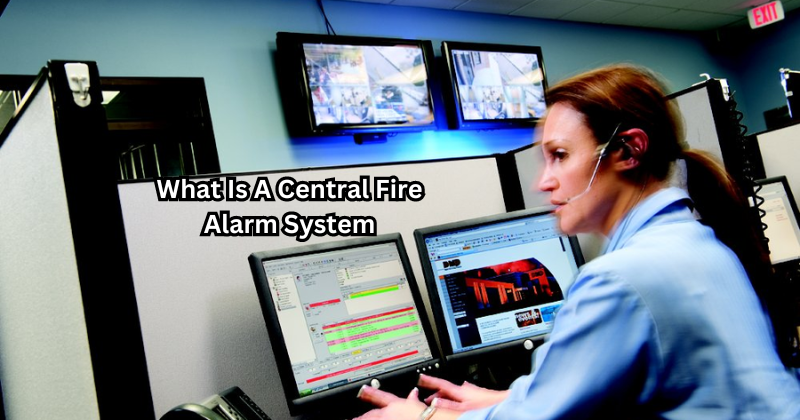A central fire alarm system is critical to any building's safety infrastructure. This networked solution detects and alerts occupants of a potential fire emergency.
By utilizing a centralized control panel, interconnected smoke detectors, heat sensors, and alarms strategically placed throughout the premises, the central fire alarm system can swiftly detect smoke or fire, triggering audible and visual alerts to notify individuals to evacuate promptly. This proactive approach not only safeguards lives but also helps in minimizing property damage by enabling rapid response from emergency services.
In essence, a central fire alarm system is the guardian of safety in residential, commercial, and industrial settings. This guide will explore the features, types, and benefits of central fire alarm systems to help you understand their crucial role in protecting lives and property.
Fire Alarm Monitoring: A Brief History
The earliest fire alarm systems date back to the 1800s when simple mechanical devices were used to detect and alert individuals of a potential fire. These early systems relied on the detection of heat or smoke to trigger an audible bell or gong, warning building occupants of danger.
In the mid-20th century, with advancements in technology, electrically powered fire alarm systems emerged. These systems utilized electrical wiring and batteries to connect multiple detectors and alarms throughout a building. However, these early systems were limited in their capabilities as they could only sound an alarm locally and did not have the ability to communicate with emergency services.
Then came the development of central fire alarm systems in the late 1960s. These revolutionary systems incorporated a centralized control panel that could receive and process signals from interconnected detectors and alarms. This allowed for a more comprehensive and efficient response to fire emergencies, as the control panel could pinpoint the exact location of the alarm and automatically notify emergency services.
What Is A Central Fire Alarm System?
A central fire alarm system is a networked solution that utilizes interconnected smoke detectors, heat sensors, and alarms to detect and alert occupants of a potential fire emergency. The central station system is designed to be highly sensitive to even the slightest changes in temperature or the presence of smoke, triggering immediate alerts for evacuation.
The central control panel acts as the brain of the system, receiving signals from various detection devices and relaying them to strategically placed alarms throughout the building. This allows for swift and precise response in case of an emergency.
On the other hand, local alarm systems are standalone units that only sound an alarm in the immediate vicinity of the fire. They cannot communicate with emergency services or provide a comprehensive overview of the situation. A local alarm system is not a substitute for a central fire alarm system, as it does not provide the same level of protection and response.
Types of Central Fire Alarm Systems
There are three main types of central fire alarm systems: conventional, addressable, and wireless.
Conventional Fire Alarm System
Conventional fire alarm systems are the most basic type of central fire alarm systems. They consist of interconnected detectors and alarms that are wired to a control panel. In case of an emergency, the control panel receives a signal from the activated detector and sounds an alarm in the corresponding zone.
Addressable Fire Alarm System
Addressable fire alarm systems are more advanced than conventional systems as they can pinpoint the exact location of an activated detector or alarm. Each device is assigned a unique address, allowing for precise identification of the source of the emergency.
This also allows for easier maintenance and troubleshooting. Fire alarms can be triggered manually or automatically through the detection of smoke or heat.
Wireless Fire Alarm System
Wireless fire alarm systems eliminate the need for wiring between devices and control panels by utilizing radio frequency communication. These systems are ideal for buildings where the installation of wired systems is not possible or practical. They offer the same benefits as conventional and addressable systems, with the added advantage of flexibility and ease of installation.
Fire department communication systems, which are used in larger buildings such as hospitals and schools, are also considered a type of central fire alarm system.
Features of Central Fire Alarm Systems
Central fire alarm systems have evolved significantly over the years with advancements in technology. Some of the key features of modern central fire alarm systems include:
- Remote monitoring and control: With the use of internet connectivity, central fire alarm systems can now be monitored and controlled remotely, providing added convenience and peace of mind.
- Integration with building management systems: Central fire alarm systems can be integrated with other building management systems, such as HVAC or access control, allowing for a more comprehensive approach to safety.
- Multiple communication methods: In addition to sounding alarms within the premises, central fire alarm systems can also send alerts through phone lines, cellular networks, or voice-over IP (VoIP) in case of an emergency.
Central monitoring station is constantly monitored by trained professionals and can dispatch emergency services immediately. Central monitoring station is constantly monitored by trained professionals and can dispatch emergency services immediately. Central station monitoring also allows for 24/7 surveillance of the system and its components, ensuring they are functioning properly at all times.
Benefits of Central Fire Alarm Systems
Many homes and businesses opt for local alarm systems, which appear to be a cost-effective and sufficient security solution. These systems provide audible warnings for various threats, including fires, intrusions, CO detection, and other hazards.
However, central fire alarm systems offer several advantages over local alarms, such as:
Round-the-Clock Coverage:
Central fire alarm systems provide 24/7 monitoring, ensuring that emergency services are immediately notified in case of a fire. This is especially crucial for commercial and industrial settings where fires can break out at any time.
Immediate Emergency Assistance:
Central fire alarm systems are designed to quickly detect and alert authorities of a potential fire, reducing response time and minimizing damage. Additionally, these systems can also include additional sensors for carbon monoxide and gas leaks. Central alarm systems also allow for direct communication with emergency services, providing a faster response.
Single-Stop Protection:
Central fire alarm systems offer comprehensive protection from various hazards in one system, reducing the need for multiple security solutions. This not only saves costs but also simplifies maintenance and monitoring.
Criminal Deterrent:
Central fire alarm systems can act as a deterrent against criminal activity, providing an extra layer of protection for homes and businesses. Furthermore, these systems can also be connected to smoke sensors and security cameras, providing a comprehensive approach to security.
Insurance Discounts:
Many insurance companies offer discounts for properties equipped with central fire alarm systems, recognizing the added safety and protection they provide.
Who Can Use Central Alarm Services?
Like any other security system, the central alarm system can be used by anyone looking to protect their property, whether it be a residential home or a commercial building.
These systems are especially beneficial for larger and more complex buildings where local alarms may not provide sufficient coverage. Central station alarm services can also be tailored to meet specific needs and requirements, making them suitable for a variety of settings.
In addition, industries such as healthcare facilities, hotels, and schools are required by law to have central fire alarm systems installed for the safety of their occupants. Furthermore, businesses with high-value assets or sensitive information can also benefit greatly from the added security provided by these systems.
Central Station Fire Alarm Requirements
The National Fire Protection Association (NFPA) has established several requirements for central station fire alarm systems, including:
- Regular testing and maintenance: Central fire alarm systems must be tested and maintained regularly to ensure proper functioning.
- Backup power supply: A backup power supply, such as a generator or battery backup, is necessary to ensure the system remains operational during power outages.
- Secure communication methods: The communication methods used by central fire alarm systems must be secure and reliable to prevent false alarms or tampering.
- Trained operators: Operators at the central monitoring station must be trained and certified in handling emergency situations and responding appropriately.
Proprietary fire alarm monitoring actually offers a higher level of security and reliability compared to non-proprietary systems.
FAQs
What is the difference between a local and a central fire alarm system?
Local fire alarm systems only provide audible alerts within the premises, while central fire alarm systems also have features such as remote monitoring and integration with other building management systems.
What is a basic alarm system?
A basic alarm system typically consists of a control panel, sensors, and an audible alarm. It is designed to detect threats such as fires and intrusions within the premises and provide a warning.
How much does a central fire alarm system cost?
The cost of a central fire alarm system varies depending on factors such as the size and complexity of the building, number of sensors, and additional features. It is best to consult with a security professional for an accurate cost estimate.
Can I monitor my central fire alarm system remotely?
Yes, many central fire alarm systems allow for remote monitoring through a smartphone app or web portal. This allows users to check the status of their system and receive alerts in case of emergencies, even when they are not on the premises.
Conclusion
In conclusion, the central fire alarm system stands as a beacon of safety, offering proactive detection, swift alerting, and coordinated response mechanisms crucial for fire emergency management. By uniting advanced technology with reliable functionality, these systems serve as integral guardians of life and property in diverse environments.
Their ability to provide early warnings, initiate evacuation procedures, and expedite emergency assistance underscores their indispensable role in mitigating fire risks and ensuring the well-being of occupants. Investing in robust central fire alarm systems is not just a regulatory requirement but a paramount commitment to safety and security.





